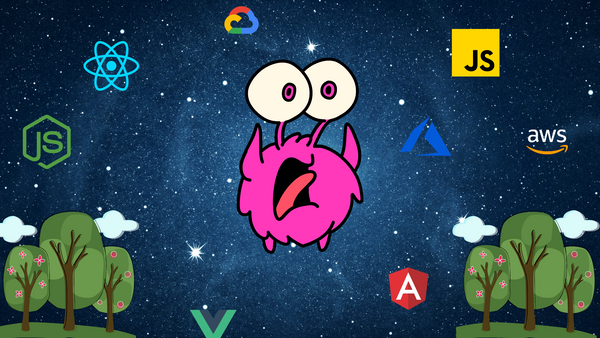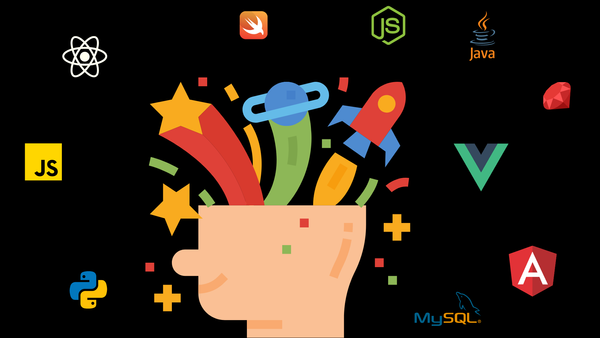JavaScript is a strange little big creature. It was created in ten days and was originally regarded as the “wannabe” programming language.
In its early days, JavaScript was the equivalent of the little guy in the garage — tinkering out snowflake effects and kitsch text-animations back in the 90’s, earning its place in the history of Internet nostalgia.
No one saw it as a job with six-figure earnings potential.
Fast-forward almost thirty years later and JavaScript is the Millennial of programming languages. It’s figured itself out, paved its own space, and is thriving in the world of app development.
JavaScript’s popularity is mostly due to it being fast to learn, fast to create, and fast to deliver.
The popular job site indeed reports the average base salary for JavaScript developers to be $115,377 per year in the United States.
How did we get from snowflakes driftingly randomly down from the screen to fully functional apps with API interfaces and connections to databases?
The Kid That Grew Up
Back in the 90s, the Internet wasn’t really a thing yet. JavaScript was a scripting language commissioned into existence by NetScape during a browser war that was going on with Microsoft.
Its hasty conception, birth, and choice of name led to scorn from those taking traditional approaches to programming. Back then, a systematized approach to bridging the gap between machine and requirements was still prevalent, rather than self-taught or community-driven learning.
JavaScript’s outsider status continued to perpetuate over the years. This perception still persists in the form of memes, despite its growing dominance as the language of choice for app and platform development.
In 2010, Apple decided to instigate the death of Flash, a third party applet, in favor of the open-source HTML5. A year before this drama ensued, Node.js came into existence, designed to improve the scalability of web applications through the ability to create real-time responses that weren’t limited to 10,000 concurrent connections.
Making Strides With Libraries and Frameworks
With the release of the package manager npm in 2010, developers were able to create and share code in a simplified and unified manner. Angular.js was also released by Google that year. The JavaScript testing framework Jasmine made its appearance, quickly followed by Mocha in November the following year.
In 2011, Bootstrap joined the fray, making rapid prototyping possible for interfaces and accelerating the growth of single-page applications to mainstream development consciousness.
jQuery hung around with Ajax and by 2015 was used in 62.7% of the top one million websites, ruling over 17% of the web. As of May 2019, jQuery runs on approximately 73% of the top 10 million websites, in some form.
Open-source initiatives, some community-driven, some backed by large organizations such as Google and Microsoft, helped accelerate JavaScript’s growth and tighten their grip on the rapidly-expanding digital spaces.
Anything You Can Do, I Can Do Too
JavaScript’s original intentions were to make the web accessible to developers. As the web grew its reach and went beyond PC-based devices, so did JavaScript’s app-development implementations.
The rise of cross-platform JavaScript-based development helped create demand for something that’s not formally taught in many computer science classes, giving rise to a new breed of self-taught developer.
As JavaScript became synonymous with the internet and its various technologies, interest and its applications in various spaces helped create unprecedented demand. The rapid growth of free, affordable, and highly accessible resources also contributed to the explosion of developers adopting a life-long-learner approach in order to keep up with the technology, standards, frameworks, libraries, and any additional developments in the JavaScript ecosystem.
The explosion of global consumer usage of the web also opened opportunities for businesses to create connections with potential users. As developers develop experience and proficiency with the language, so their wages trend upwards.
How Did JavaScript Devs Start Demanding +$100k Salaries?
It’s easy to pick up JavaScript. But many businesses are starting to understand that the quality of apps delivered also depends on the quality of the developer.
Investing in a developer is investing in the business and the cheapest dev on the block doesn’t always guarantee the highest quality or strategic long term thinking abilities.
When it comes to hiring a dev, a quality developer with good track history and projects to show often have the commanding power for higher pay, depending on area, availability and what kind of deliverables they’ve worked on in the past.
It’s been almost a decade since JavaScript’s dramatic explosion, which means that the matching demographic for experience is also expecting a certain level of pay progression. When mixed with a low bar for entry, experience can be a deal-breaker for salary negotiations.
Competition on the market may be fierce due to saturation, but the ability to create things quickly and in a robust manner can make or break businesses — especially startups looking to launch products with a lean and MVP mindset.
In order to attract talent with the right kind of historical relationship with JavaScript, companies are willing to pay more for the right person. Due to JavaScript’s versatility and permeance across multiple platforms and devices, the knowledge, experience, frameworks, and understanding of libraries can make or break the deliverables needed.
Final Thoughts
Despite being easy to pick up, coding is still not accessible to everyone. Businesses have ideas that need to be implemented and that’s what developers are for. The supply of JavaScript developers are plentiful, but the standard and quality of developers are not always guaranteed.
As an industry, the ability to create code now requires more than just the ability to churn out classes and functions. There’s also more to making interfaces look pretty. Code creation in 2020 is now a melting pot of cross-functional skills that were first defined under the umbrella of the full-stack developer — the one person who can do it all.
JavaScript is the easiest to create a full-stack option, in contrast to everything that’s currently available. With the addition of cloud infrastructure providers widely supporting Node.js, JavaScript is now essentially most of the web thanks to its adaptability, giving rise to the demand and price to match the expected and needed quality of output.







